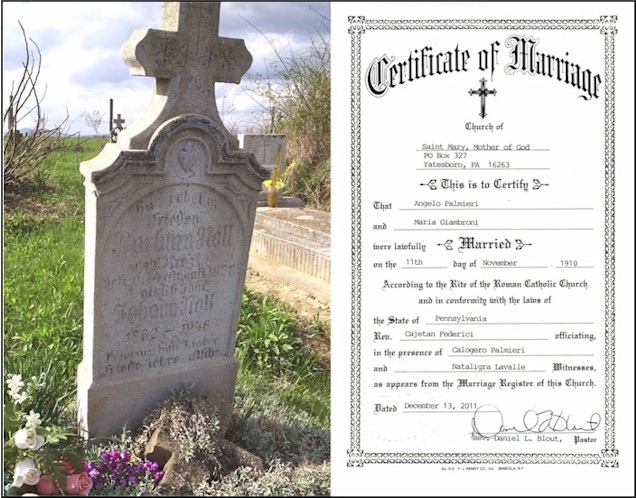
© 2015 50plus Senior News, All rights
reserved
The Search for Our Ancestry: Which Records Take Precedence?
Angelo Coniglio | May 3, 2011, 4:22 p.m.

Q: My grandmother’s tombstone says she was born Dec. 26, 1893, in Germany. She was married in the United States. Her marriage certificate gives her marriage date as Nov. 30, 1912, and her birth date as Dec. 26, 1894. After I sent to her birthplace for a birth certificate, I received a document in German that is headed “EXTRAKT” and gives her birth date as Dec. 28, 1893. Which birth date is right?
– S.L.
A: Each of the records you describe is a secondary record. That is, they were not made at the actual time and place of your grandmother’s birth. Any of them might be correct, but all of them could be in error. A primary record is an official record made at the time and place of the event, and as such takes precedence over any other records.
First, the gravestone: Unless stones are preplanned, the dates on grave markers are usually given to the stone carver by a relative or friend of the deceased. That is, the date is hearsay, not supported by an actual document, so it could be, and often is, incorrect.
That may not be of much importance to survivors, if they are not interested in tracing the family heritage back in time. But if they are, the most accurate records are needed, since there may have been more than one person with the same or similar names and birth dates, and you want to be sure you’re finding information on your ancestors, not those of someone else!
The marriage certificate: The marriage certificate is a primary record of the marriage, and that date can be considered official. But often in those days, when immigrants had few official records with them, they were simply asked their birth date (and other pertinent information), which was entered on the marriage certificate as a secondary record of the person’s birth.
Your grandmother may simply have not remembered her exact birth date. In Germany in the 1890s, “birth certificates” were not issued to a child’s parents; instead, the birth was recorded in an annual ledger with all other births from that year, either in a civil register, a church register, or both. The family had no “certificate” that they could readily or frequently refer to, and exact dates of birth may not have been very important to them.
Since Grandmama was evidently born near the end of the year, her family may have remembered her birthday in association with “the winter of 1893-1894” and forgotten the exact year.
The German document: Extrakt is German for “extract”; that is, a document on which pertinent information is hand-copied from an original. It is not a photocopy of the original, and while it is an official document, it is still a secondary record. The clerk or official who copied it down may have made a mistake in transcribing the information.
For example, your grandmother’s official, primary birth record might very well say that she was born on Dec. 26, 1893. However, births were not necessarily recorded on the day they happened. The first date appearing on the original birth record is the date the birth was reported. In this case, the baby could have been born on Dec. 26, but not brought in to be registered until the 28th. The modern clerk who answered your request may have read the record date in the
While we can’t traipse over the world at will to look at original records, we can search for the town using the Mormon website www.familysearch.org to determine whether microfilms exist of its birth registers for the late 1890s. If they do, the films can be ordered at a Mormon Family History Center, and after they arrive, they can be viewed at the center.
Search the films for the years in question, and when you find the primary record, you’ll know your grandmother’s correct birth date. Be open-minded. Don’t say, “That can’t be her; that’s not what her gravestone says.” The gravestone may be wrong. The primary record takes precedence.
Further, the original record will often contain much more than was transcribed onto the extract—for example, the father’s age, occupation, and address, and possibly the mother’s maiden name and age. Their ages can then be used to determine their approximate birth years, so that you can search for their birth records, extending your family tree.
Now that I’ve explained primary records, to be strictly correct, I must add a point. In many cases, in many countries, duplicate records were required to be sent to jurisdictions higher than the town of birth—for example, a provincial or county seat, or a special tribunal that maintained archives of the records.
Prior to the 20th century, the only way to produce duplicate records was to have the clerk draw up handwritten copies to be sent to the other jurisdictions. While the same clerk made all the copies, each copy after the original is technically a secondary record. The clerk may have erred on the copies.
When the Mormons microfilmed documents, for convenience it was generally at a place where records from more than one town were stored, such as a tribunal or provincial archive. Most genealogists accept the information from these higher jurisdictions as primary records, but if a serious discrepancy is suspected, it may be necessary for you or a representative to examine the town’s original register.
|
Write to Angelo at genealogytips@aol.com or visit his
website, www.bit.ly/AFCGen.
He is the author of the book The Lady of the Wheel (La Ruotaia), based on his genealogical research of Sicilian foundlings. For more information, see www.bit.ly/SicilianStory. |





